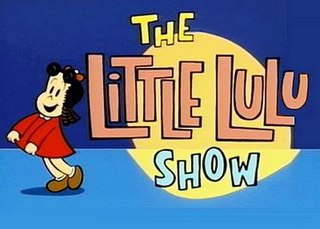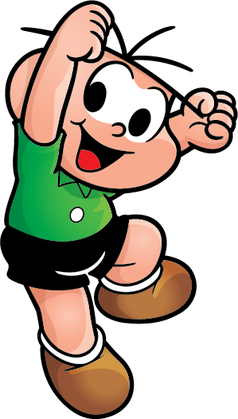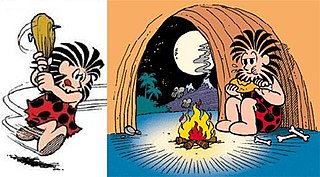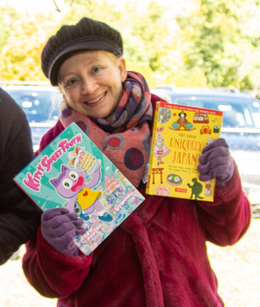
Little Lulu is a comic strip created in 1935 by American author Marjorie Henderson Buell. The character, Lulu Moppet, debuted in The Saturday Evening Post on February 23, 1935, in a single panel, appearing as a flower girl at a wedding and mischievously strewing the aisle with banana peels. Little Lulu replaced Carl Anderson's Henry, which had been picked up for distribution by King Features Syndicate. The Little Lulu panel continued to run weekly in The Saturday Evening Post until December 30, 1944.

Monica and Friends, previously published as Monica's Gang in Anglophone territories, and as Frizz and Friends in London, is a Brazilian comic book series and media franchise created by Mauricio de Sousa.

Maurício Araújo de Sousa is a Brazilian cartoonist and businessman who has created over 200 characters for his popular series of children's comic books named "Turma da Mônica" or "Monica and Friends".

The Little Lulu Show is an animated series based on Marjorie Henderson Buell's comic book character Little Lulu. The series first aired in 1995 and ended in 1999.
Lea Hernandez is an American comic book and webcomic creator, known primarily for working in a manga-influenced style, and for doing lettering and touch-ups on manga imports. She is the co-creator of Killer Princesses, written by Gail Simone and published by Oni Press; and the creator of Rumble Girls from NBM Publishing.

Jimmy Five, known as Cebolinha in Portuguese, is one of Monica and Friends' main characters. He was created in 1960, at first as a support character for Franklin and Blu who the following year became the protagonist of his own series of newspaper strips, which was later replaced by the character Monica in the 70s. Currently Jimmy Five has his own printed comic book, called Cebolinha, which was first released in 1973.

Chuck Billy 'n' Folks is a Brazilian comic strip and part of the Monica's Gang comic book series, created by Mauricio de Sousa.

The Cavern Clan (Piteco) is a Brazilian comic strip created in 1961 by Mauricio de Sousa. It is part of the Monica's Gang series.

Tina's Pals is a Brazilian comic strip series, part of the Monica's Gang series, created in 1970. The stories are aimed at a more teenage group of readers, rather than the kids who would read other Mauricio de Sousa's works and thus center around teenagers and young adults. However, Mauricio prefers not to mention drugs, topics about sexuality, or other similar subjects, which are very popular among teenagers. Instead, the strips are written with themes related to school or university, dating, problems with parents, etc.

The Funnies, also known as Bubbly the Astronaut, is a Brazilian comic strip series, created in 1963 and part of the Monica's Gang comic strips. It centers around Bubbly, an astronaut, whose parents and ex-girlfriend Rita appear very rarely, making him the only recurring character. The comic strip can be defined as a science fiction adventure strip.
Lionel's Kingdom is a Brazilian comic strip created in 1961 and part of the Monica's Gang comic strips.

Monica is a Brazilian fictional character and Mauricio de Sousa's best-known creation. Introduced in 1963, she serves as the main protagonist and title character of the Monica and Friends comic book series and media franchise.

Abby Denson is an American cartoonist, writer, and musician, known for her gay young-adult comics series Tough Love and her comics travel guides to Tokyo and Japan.

John Stanley was an American cartoonist and comic book writer, best known for writing Little Lulu comic book stories from 1945 to 1959. While mostly known for scripting, Stanley also drew many of his stories, including the earliest issues of Little Lulu and its Tubby spinoff series. His specialty was humorous stories, both with licensed characters and those of his own creation. His writing style has been described as employing "colorful, S. J. Perelman-ish language and a decidedly bizarre, macabre wit ", with storylines that "were cohesive and tightly constructed, with nary a loose thread in the plot". He has been compared to Carl Barks, and cartoonist Fred Hembeck has dubbed him "the most consistently funny cartoonist to work in the comic book medium". Captain Marvel co-creator C. C. Beck remarked, "The only comic books I ever read and enjoyed were Little Lulu and Donald Duck".

Little Lulu and Her Little Friends is a Japanese anime television series produced by Nippon Animation, based on Little Lulu comic by US cartoonist Marjorie Henderson Buell (Marge). The series was animated and directed by Fumio Kurokawa.

Tubby Tompkins, generally referred to as Tubby, is a comic book character created by Marjorie Henderson Buell. The character Thomas "Tubby" Tompkins first appeared in the Little Lulu comic panel in The Saturday Evening Post and went on to appear alongside Lulu in comic books, advertising, and animated cartoons, as well as in his own solo comic book series beginning in 1952.
Although, traditionally, female comics creators have long been a minority in the industry, they have made a notable impact since the very beginning, and more and more female artists are getting recognition along with the maturing of the medium. Women creators have worked in every genre, from superheroes to romance, westerns to war, crime to horror.
Khary Randolph is an American comic book artist. He has worked on such series as Starborn, Charismagic, Tech Jacket, Mosaic, and Excellence; and for such publishers as Marvel Comics, Epic Comics, DC Comics, Aspen Comics, Image Comics, and Boom! Studios.













